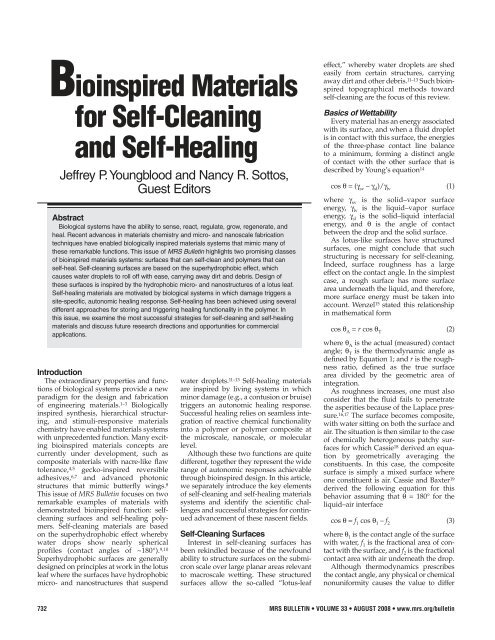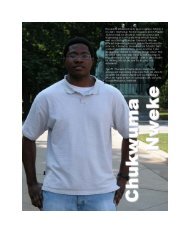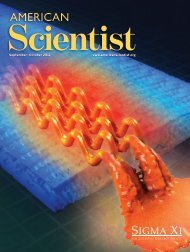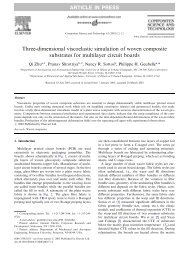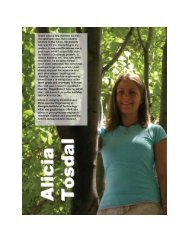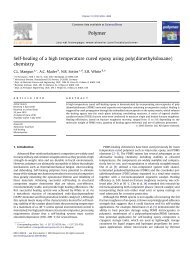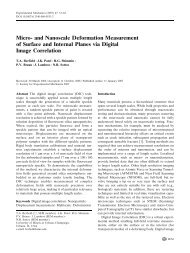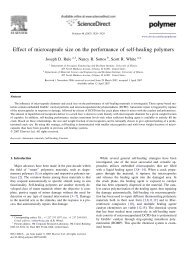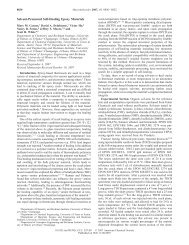Bioinspired Materials for Self-Cleaning and Self-Healing - Sottos ...
Bioinspired Materials for Self-Cleaning and Self-Healing - Sottos ...
Bioinspired Materials for Self-Cleaning and Self-Healing - Sottos ...
- No tags were found...
Create successful ePaper yourself
Turn your PDF publications into a flip-book with our unique Google optimized e-Paper software.
<strong>Bioinspired</strong> <strong>Materials</strong> <strong>for</strong> <strong>Self</strong>-<strong>Cleaning</strong> <strong>and</strong> <strong>Self</strong>-<strong>Healing</strong><strong>Self</strong>-<strong>Cleaning</strong> Surfaces:An Industrial PerspectiveChuck Extr<strong>and</strong>As an industrial researcher, I am frequently asked to update business leaders <strong>and</strong>executives at the company where I work on the progress of our projects. In 2002, duringone of our technology update <strong>for</strong>ums, we showed water bouncing off a superhydrophobicsurface that we had created <strong>and</strong> then allowed several executives to trybouncing drops themselves. The initial response was a combination of amazement<strong>and</strong> excitement. Enthusiasm quickly waned when one of our executives innocentlytouched the surface with his finger, destroying its superhydrophobic nature. For me,this example captures the general state of bioinspired <strong>and</strong> self-cleaning surfaces:They have great potential, but many practical challenges still remain.Much of the recent work has looked to nature <strong>for</strong> inspiration. However, simplymimicking nature’s designs might not be effective. Natural surfaces generally havea number of advantages—they often have the ability to repair or renew themselves(e.g., plants) or are short-lived (e.g., insects). Most bioinspired <strong>and</strong> self-cleaning surfaceshave been laboratory curiosities, yet there have been few commercial successes.Water-repellent fabrics are one of the prevalent examples in the marketplace.Why have self-cleaning surfaces not become ubiquitous? Most surfaces producedtoday cannot withst<strong>and</strong> high hydrostatic pressures <strong>and</strong> are easily damaged. If a selfcleaningsurface fails, then liquids stick more tenuously than if the surface had notbeen treated at all.How can researchers make an impact? By following one of two paths: pursuingfundamental research or creating practical surfaces. For the fundamental researchpath, the focus should not be the Cassie <strong>and</strong> Wenzel equations <strong>and</strong> theoretical highcontact angles. The dogma <strong>and</strong> polemics that surround these fundamentally flawedconstructs only fetter creativity <strong>and</strong> slow progress. Promising work by Gao et al. inthis issue suggests one path <strong>for</strong> fundamental research.The alternative path involves applied research into practical surfaces. Such surfacesmust be self-cleaning in practice, durable, <strong>and</strong> easy to manufacture. Surfacesshould prevent penetration of high-pressure liquids during immersion, flow, orspraying <strong>and</strong> then dispatch the liquids with minimal <strong>for</strong>ces or pressures (from inclination,shaking, spinning, <strong>and</strong> so on). Any practical surface also must withst<strong>and</strong>touching or rubbing, as well as exposure to environmental contamination. The manufacturingprocess must be quick <strong>and</strong> versatile. The introductory article lists a toolboxof reported methods to make such materials. The process cannot take days <strong>and</strong>must be suitable <strong>for</strong> a broad array of surfaces beyond silicon wafers. If we canaccomplish this, someday, our houses, cars, boats, <strong>and</strong> clothing might be coveredwith these highly engineered surfaces.from that dictated by surface energetics. 20Nonuni<strong>for</strong>mities raise the contact angle ofa drop advancing across a surface abovethe thermodynamic value, whereas thecontact angle of a drop receding across asurface will be depressed. This contactangle hysteresis (the difference betweenthe advancing angle <strong>and</strong> the recedingangle) thus gives a measure of the degreeof nonuni<strong>for</strong>mity of the surface, withgreater amounts of hysteresis indicatinghigher degrees of imperfection.A drawback of the Wenzel <strong>and</strong>Cassie–Baxter constructions is their inabilityto account <strong>for</strong> the advancing <strong>and</strong>receding contact angles. (For more in<strong>for</strong>mationon other limitations, see the articlein this issue by Geo et al.) Johnson<strong>and</strong> Dettre 17,21–24 proposed a model inwhich the rough surface causes meta -stable local minimum states that trap thethree-phase contact line. Their modelcorrectly predicts both the advancing<strong>and</strong> receding contact angles <strong>and</strong> the hysteresisbetween them, which phenom -enologically corresponds to observedbehavior, 22,25,26 as shown graphically inFigure 1a.<strong>Bioinspired</strong> Structured SurfaceIn the design of self-cleaning surfaces,the ability of the surface to shed wateris of paramount importance. The <strong>for</strong>cerequired to move a drop across a surface,<strong>and</strong> there<strong>for</strong>e the angle at which a dropslides off the surface, is proportional to thecontact angle hysteresis, according to 27–30F γ LV(cos θ rec– cos θ adv) (4)Thus, the key to repellency is in reducingthe hysteresis <strong>and</strong> not necessarily theactual surface energy. Surfaces that exhibitnear-zero hysteresis of water <strong>and</strong>, there<strong>for</strong>e,have drops that move readily arethus termed superhydrophobic.According to the plot of Johnson <strong>and</strong>Dettre 24 of the water contact angle on a surfacewith sinusoidal roughness (Figure 1a),the contact angle on the surface has lowcontact hysteresis above a critical roughnessvalue. That value also corresponds tothe transition between behavior caused bythe increased surface area defined by theWenzel equation <strong>and</strong> behavior of a compositesurface as dictated by Cassie.Whereas the physical heterogeneity of theroughness acts to increase hysteresis, thecomposite nature of the surface lessens thiseffect, as air has no hysteresis. This regionis the superhydrophobic region. A dropletin this region has almost no energetic barrierto motion <strong>and</strong> moves easily. 26,31–33The superhydrophobic effect is the originof self-cleaning. 11,12,34,35 As the nearlyspherical water droplets roll around, theyencounter debris <strong>and</strong> other particulates.The debris is loosely bound to the surfacebecause the structuring provides few contactpoints, so that the surface tension of thewater “grabs” the material <strong>and</strong> localizes itto the surface of the drop. Eventually, theease of motion allows the droplet to slideoff the surface with very little resistance,thus carrying the debris off the surface aswell.In nature, insects use superhydrophobicityto great effect to accomplish such featsas walking on water. The water strider hashierarchical structure at the end of its legs(tarsi) with protrusions called setae, each atthe tens-of-microns scale, with grooves atthe hundreds-of-nanometers scale (Figure1b). 36 These structures, coupled with inherenthydrophobicity, allow the water striderto attain extremely high fractions of air atthe leg–water interface. Essentially walkingon air, this insect can move freely aboutthe surface of water, as the high contactangle overcomes gravity <strong>and</strong> the low hysteresisallows the leg to move onto <strong>and</strong> offof the water surface with ease.Nature uses similar methods to attainself-cleaning structures (Figure 1b), suchMRS BULLETIN • VOLUME 33 • AUGUST 2008 • www.mrs.org/bulletin 733
<strong>Bioinspired</strong> <strong>Materials</strong> <strong>for</strong> <strong>Self</strong>-<strong>Cleaning</strong> <strong>and</strong> <strong>Self</strong>-<strong>Healing</strong>aContact angle, θ (degrees)180170(1)160150(2)140130 (3)12011010090 (4)801.0 2.0Roughness ratio, rbcdef167 g3.0–5.0µmcreate a contact angle greater than 150°with hysteresis of only a few degrees. 37These values allow the water drops toslide off with ease, carrying dirt <strong>and</strong>debris with them—the essence of superhydrophobicity-derivedself-cleaning.OutlookHereto<strong>for</strong>e, the aim of many superhydrophobicity<strong>and</strong> self-cleaning researchershas been the elucidation <strong>and</strong> physicalexplanation of the key features necessaryto achieve lotus-like surfaces. Factors suchas size scale, 9,26 topology, 31,33 <strong>and</strong> multiscalestructure 38,39 are of utmost importance.Others have focused on a toolboxof methods <strong>for</strong> creating these materials.A variety of superhydrophobic surfacesobtained using dry methods such asplasma modification, 26,40 laser etching, 41<strong>and</strong> templating 42 <strong>and</strong> wet methods suchas layer-by-layer deposition, 43 colloidalassembly, 44 electrospinning, 45–47 <strong>and</strong> solventevaporation 48 have been reported.Going <strong>for</strong>ward, the chief issue thatmust be addressed <strong>for</strong> these materialsto realize their ultimate potential assuper hydrophobic materials is a lack ofmechanical integrity. Because the superhydrophobiceffect is essentially topographical,any loss of structuring leads toloss of self-cleaning. Un<strong>for</strong>tunately, at thenecessary size scales, robustness is generallyunattainable. As self-cleaning surfaceswill likely be used in systems where periodicmechanical cleaning (as in windows)or aggressive water flow (as in boat hulls)is necessary, the ability to resist abrasion iskey. Use of stronger materials such as metalsor ceramics will help mitigate thisissue. However, an even better approachwould be to combine self-cleaning propertieswith the ability to self-heal. For materialsthat achieved such a combination, thesurface would eventually recover allsuperhydrophobic behavior even afterbeing scratched, wiped with a rag, orslammed against a dock. Such self-healingmaterials are considered next.Figure 1. (a) Plots of contact angle versus roughness <strong>for</strong> (1) Wenzel’s equation, (2) Cassie<strong>and</strong> Baxter’s equation, <strong>and</strong> Johnson <strong>and</strong> Dettre’s work <strong>for</strong> both the (3) advancing <strong>and</strong> (4)receding angles on a surface of sinusoidal roughness. 24 (b–d) Superhydrophobic structuresfrom nature: (b) water strider leg microstructure, 36 (c) water strider leg nanogrooves, 36 <strong>and</strong>(d) lotus leaf. 13 (e–g) Synthetic superhydrophobic structures: (e) photolithographed posts, 33(f) templated polymers nanofibers, 42 <strong>and</strong> (g) solvent structured surface. 48as butterfly wings, 35 cicada wings, 37 <strong>and</strong>lotus leaves, 11–13 the latter being a notableexample <strong>and</strong> the reason superhydrophobicityis also termed the lotus-leaf effect.Much like the water strider, the lotus hasmultiple-length-scale roughness on thesurface of its leaves with protrusions oftens of microns that are themselves eachbumpy at the scale of hundreds ofnanometers. 11–13 The structures of the leaf<strong>Self</strong>-<strong>Healing</strong> PolymersStructural polymers are used in applicationsranging from adhesives to coatingsto microelectronics to composite airplanewings, but they are highly susceptible todamage in the <strong>for</strong>m of cracks. Thesecracks often <strong>for</strong>m deep within the structure,where detection is difficult <strong>and</strong>repair is almost impossible. Regardless ofthe application, once cracks have <strong>for</strong>medwithin polymeric materials, the integrityof the structure is significantly compromised.The addition of self-healing functionalityto polymers provides a novelsolution to this long-st<strong>and</strong>ing problem734 MRS BULLETIN • VOLUME 33 • AUGUST 2008 • www.mrs.org/bulletin
<strong>Bioinspired</strong> <strong>Materials</strong> <strong>for</strong> <strong>Self</strong>-<strong>Cleaning</strong> <strong>and</strong> <strong>Self</strong>-<strong>Healing</strong><strong>and</strong> represents the first step in the developmentof materials systems with greatlyextended lifetimes.In biological systems, chemical signalsreleased at the site of fracture initiate asystemic response that transports repairagents to the site of injury <strong>and</strong> pro -motes healing (Figure 2a). The biologicalprocesses that control tissue responseto injury <strong>and</strong> repair are extraordinarilycomplex, involving inflammation, woundclosure, <strong>and</strong> matrix remodeling. 49 Coagulation<strong>and</strong> inflammation begin immediatelywhen tissue is wounded. After about24 hours, cell proliferation <strong>and</strong> matrixdeposition begin to close the wound.During the final stage of healing (whichcan take several days), the extracellularmatrix is synthesized <strong>and</strong> remodeled asthe tissue regains strength <strong>and</strong> function.Ideally, synthetic reproduction of the healingprocess in a material requires an initialrapid response to mitigate further damage,efficient transport of reactive materialsto the damage site, <strong>and</strong> structuralregeneration to recover full per<strong>for</strong>mance.Although no materials system yetaccomplishes this complete set of autonomichealing processes, crack healinghas been explored in a wide spectrum ofmaterials. 50 The efficiency of crack healing<strong>for</strong> structural materials is defined as theability to recover the mechanical integrityof the virgin (undamaged) material,including such properties as fracturetoughness (K IC ), fracture energy (G c ), elasticstiffness (E), <strong>and</strong> strength (σ ult ). Forsome materials systems, healing isachieved autonomically (independently<strong>and</strong> automatically) without any externalintervention, whereas others require additionalenergy (such as heat) to heal.In polymers <strong>and</strong> polymer composites,two distinct approaches <strong>for</strong> self-healinghave emerged. In the first, the crackmendingprocess is initiated by an externalthermal-, photo-, mechanical- or chemicalinducedstimulus. Successful crack healinghas been achieved through both moleculardiffusion <strong>and</strong> thermally reversible solidstatereactions. In the second approach,damage in the <strong>for</strong>m of a crack triggers therelease of healing agents stored in thematerial, as also occurs <strong>for</strong> fracture eventsin biological systems (Figure 2b). Bothcompartmentalized <strong>and</strong> continuous deliverystrategies have been demonstrated.Site-specific crack healing is achievedautonomically in this approach, withoutany external intervention.Thermally Induced Crack MendingCrack healing has been achieved in arange of polymer systems through the useof heat <strong>and</strong> pressure to promote diffusionabepidermiscrackgranulationtissuefibrin clotof polymer chains <strong>and</strong>/or chemicalchanges (Figure 3). In many cross-linkedpolymers, healing occurs through chaininterdiffusion if there is physical contactbetween the crack planes <strong>and</strong> sufficientviscoelastic de<strong>for</strong>mation <strong>and</strong> wetting. 51,52An increase of the temperature above theglass transition, T g , <strong>and</strong> application ofpressure significantly enhance the mendingprocess. 51 The manual addition of solventalso promotes polymer healing byeffectively lowering T g . 53 For certainionomers, self-healing is triggered by thermalenergy transferred to the polymerduring a projectile puncture event. 54Thermally induced reversible polymerizations,in which the material contains areversible or dynamic covalent bond, havealso been exploited <strong>for</strong> crack healing.Chen <strong>and</strong> co-workers used a retroDiels–Alder strategy to prepare thermallyrepairable cross-linked polymers (Figure3). 55,56 With the application of heatbloodvesselsdermis1 2 3Figure 2. (a) Schematic of an intermediate stage of biological wound healing in skin.Tissue damage triggers bleeding, which is followed by the <strong>for</strong>mation of a fibrin clot.Fibroblast cells migrate to the wound site enabling the creation of granulation tissue tofill the wound. 49 (b) Demonstration of bioinspired damage-triggered release of amicroencapsulated healing agent in a polymer specimen: ➀ schematic ofcompartmentalized healing agent stored in a matrix; ➁ release of dyed healing agent intothe crack plane, which leads to a synthetic clotting (polymerization) process to bond thecrack faces; <strong>and</strong> ➂ one-half of the fracture surface revealing ruptured capsules.(120–150°C) <strong>and</strong> modest pressure, thesepolymers demonstrate high crack-healingefficiencies based on recovery of fracturetoughness. 55–57 More recently, a thermoreversible,self-healing rubber based onhydrogen bonding has been reported. 58Details on the underlying chemistry ofthese <strong>and</strong> several new polymer systemsare described in the article by Williamset al. in this issue.Trigger <strong>and</strong> Release <strong>for</strong> Autonomic<strong>Healing</strong>Polymers that self-heal with no externalintervention rely on the quiescent, stablestorage of liquid healing agents <strong>and</strong> anactivator or catalyst within the material.The healing components must remainactive <strong>and</strong> separated until damage occurs,without significantly impacting the inherentproperties of the material. Effectivestorage <strong>and</strong> release has been achievedwith healing-agent-filled microcapsulesMRS BULLETIN • VOLUME 33 • AUGUST 2008 • www.mrs.org/bulletin 735
<strong>Bioinspired</strong> <strong>Materials</strong> <strong>for</strong> <strong>Self</strong>-<strong>Cleaning</strong> <strong>and</strong> <strong>Self</strong>-<strong>Healing</strong>have such multiscale hierarchical structures.The third article, by Tuteja et al.,describes how re-entrant curvature (acurving of the surface of the asperitiesaway from the three-phase contact line asthe water penetrates into the surface) isa dominant effect in superhydrophobicsurfaces <strong>and</strong> that proper control can evenlead to superoleophobic materials. Thelow-energy oils can be in the Cassie state,in which a rough surface under a liquidhas a composite interface of liquid contact<strong>and</strong> air contact, <strong>and</strong> display unique wettingproperties.The second half of the issue switchesfocus to the growing field of self-healingpolymers. The article by Williams et al.provides an overview of the chemistriesused in self-healing materials, as well asthose currently in development. <strong>Self</strong>healingmaterials are divided into twoconceptually distinct classes based on theunderlying chemistry: autonomic <strong>and</strong>nonautonomic. The second article, byWhite et al., focuses on polymer systemsthat heal in an autonomic fashion, withoutthe need <strong>for</strong> human intervention.Attention is directed toward describingthe types of systems under development<strong>and</strong> how these remarkable materials function.The issue closes with the article byBond et al., which describes the variousself-healing technologies currently beingdeveloped <strong>for</strong> applications in fiberrein<strong>for</strong>cedpolymeric composite materials.All three articles offer perspectives onfuture self-healing approaches.AcknowledgementsN.R. <strong>Sottos</strong> gratefully acknowledges thesupport of the U.S. Air Force Office ofScientific Research (grant Nos. FA9550-06-1-0553 <strong>and</strong> FA9550-05-1-0346), the U.S.Army Research Office (grant No. W911NF-07-1-0409), <strong>and</strong> the National ScienceFoundation (grant Nos. CMS 05-27965 <strong>and</strong>CMS 02-18863), as well as the contributionsof the Autonomic <strong>Materials</strong> Systems Groupat the University of Illinois BeckmanInstitute. J.P. Youngblood acknowledgesthe support of the Purdue ResearchFoundation.References1. F. Barthelat, Philos. Trans. R. Soc. A 365, 2907(2007).2. R. Ballarini, A.H. Heuer, Am. Sci. 95, 422(2007).3. P. Fratzl, J. R. Soc. Interface 4, 637 (2007).4. S. Deville, E. Saiz, R.K. Nalla, A.P. Tomsia,Science 311, 515 (2006).5. Z.Y. Tang, N.A. Kotov, S. Magonov, B.Ozturk, Nat. Mater. 2, 413 (2003).6. E.P. Chan, C. Greiner, E. Arzt, A.J. Crosby,MRS Bull. 32, 496 (2007).7. A. Jagota, C.-Y. Hui, N.J. Glassmaker, T.Tang, MRS Bull. 32, 492 (2007).8. A.R. Parker, H.E. Townley, Nat. Nanotechnol.2, 347 (2007).9. C.W. Extr<strong>and</strong>, Langmuir 22, 1711 (2006).10. M. Ma, R.M. Hill, Curr. Opin. ColloidInterface Sci. 11, 193 (2006).11. W. Barthlott, C. Neihhuis, Planta 202, 1(1997).12. R. Furstner, W. Barthlott, C. Neinhuis, P.Walzel, Langmuir 21, 956 (2005).13. C. Neinhuis, W. Barthlott, Ann. Bot. 79, 667(1997).14. A.W. Adamson, A.P. Gast, PhysicalChemistry of Surfaces (Wiley, New York, 1997),p. 353.15. R.N. Wenzel, Ind. Eng. Chem. 28, 988(1936).16. A.W. Adamson, A.P. Gast, PhysicalChemistry of Surfaces (Wiley, New York, 1997),p. 364.17. R.H. Dettre, R.E. Johnson, Wetting (Societyof Chemical Industry, London, 1967), p. 144.18. A.B.D. Cassie, Trans. Faraday Soc. 75, 5041(1952).19. A.B.D. Cassie, S. Baxter, Trans. Faraday Soc.3, 16 (1944).20. A.W. Adamson, A.P. Gast, PhysicalChemistry of Surfaces (Wiley, New York, 1997),p. 355.21. R.H. Dettre, R.E. Johnson, Adv. Chem. Ser.43, 136 (1964).22. R.E. Johnson, R.H. Dettre, Adv. Chem. Ser.43, 112 (1964).23. R.E. Johnson, R.H. Dettre, J. Phys. Chem. 68,1744 (1964).24. R.E. Johnson, R.H. Dettre, “Wettability <strong>and</strong>Contact Angles,” in Surfaces <strong>and</strong> Colloids, E.Matijevic, Ed. (Wiley-Interscience, New York,1969), vol. 2, p. 85.25. F. Garbassi, M. Morra, E. Occhiello,Langmuir 5, 872 (1989).26. J.P. Youngblood, T.J. McCarthy, Macromolecules32, 6800 (1999).27. C.W. Extr<strong>and</strong>, Y. Kumagai, J. ColloidInterface Sci. 170, 515 (1995).28. H.V. Nguyen, S. Padmanabhan, W.J.Desisto, A. Bose, J. Colloid Interface Sci. 115, 410(1987).29. D. Quere, Langmuir 14, 2213 (1998).30. Z. Yoshimitsu, A. Nakajima, T. Watanabe,K. Hashimoto, Langmuir 15, 5818 (2002).31. W. Chen, A.Y. Fadeev, M.C.O. Hsieh, D., J.P.Youngblood, T.J. McCarthy, Langmuir 15, 3395(1999).32. X.-M. Li, D. Reihhoudt, M. Crego-Calama,Chem. Soc. Rev. 36, 1350 (2007).33. D. Oner, T.J. McCarthy, Langmuir 16, 7777(2000).34. R. Blossey, Nat. Mater. 2, 301 (2003).35. J. Genzer, K. Efimenko, Biofouling 22, 339(2006).36. X. Gao, L. Jiang, Nature 432, 36 (2004).37. T. Sun, L. Feng, X. Gao, L. Jiang, Acc. Chem.Res. 38, 644 (2005).38. L. Gao, T.J. McCarthy, Langmuir 22, 2966(2006).39. N.A. Patankar, Langmuir 20, 8209 (2004).40. I. Woodward, W.C.E. Schofield, V. Roucoules,J.P.S. Badyal, Langmuir 19, 3432 (2003).41. M. Thieme, R. Frenzel, S. Schmidt, F. Simon,A. Henning, H. Worch, K. Lunkwitz, D.Scharnweber, Adv. Eng. Mater. 3, 691 (2001).42. L. Zhang, Z. Zhou, B. Cheng, J.M.DeSimmone, E.T. Samulski, Langmuir 22, 8576(2006).43. R.M. Jisr, H.H. Rmaile, J.B. Schlenoff,Angew. Chem., Int. Ed. 44, 782 (2005).44. G. Zhang, D.Y. Wang, Z.Z. Gu, H.Mohwald, Langmuir 21, 4713 (2005).45. S. Agarwal, S. Horst, M. Bognitzki,Macromol. Mater. Eng. 291, 592 (2006).46. M.L. Ma, Y. Mao, M. Gupta, K.K. Gleason,G.C. Rutledge, Macromolecules 38, 9742 (2005).47. Y. Zhu, J.C. Zhang, Y.M. Zheng, Z.B.Huang, L. Feng, L. Jiang, Adv. Funct. Mater. 16,568 (2006).48. H.Y. Erbil, A.L. Demirel, Y. Avci, O. Mert,Science 299, 1377 (2003).49. A.J. Singer, R.A.F. Clark, N. Engl. J. Med.341, 738 (1999).50. S. van der Zwaag, Ed., <strong>Self</strong> <strong>Healing</strong><strong>Materials</strong>: An Alternative Approach to 20 Centuriesof <strong>Materials</strong> Science (Springer, Dordrecht, TheNetherl<strong>and</strong>s, 2007).51. H.H. Kausch, K. Jud, Plast. Rubber Process.Appl. 2, 265 (1982).52. R.P. Wool, Polymer Interfaces: Structure <strong>and</strong>Strength (Hanser Press, New York, 1995).53. T. Wu, S. Lee, J. Polym. Sci. B: Polym. Phys.32, 2055 (1994).54. S.J. Kalista, T.C. Ward, J. R. Soc. Interface 4,405 (2007).55. X.X. Chen, M.A. Dam, K. Ono, A. Mal, H.B.Shen, S.R. Nutt, K. Sheran, F. Wudl, Science 295,1698 (2002).56. X.X. Chen, F. Wudl, A.K. Mal, H.B. Shen,S.R. Nutt, Macromolecules 36, 1802 (2003).57. T.A. Plaisted, S. Nemat-Nasser, Acta Mater.55, 5684 (2007).58. P. Cordier, F. Tournilhac, C. Soulié-Ziakovic,L. Leibler, Nature 451, 977 (2008).59. E.N. Brown, N.R. <strong>Sottos</strong>, S.R. White, Exp.Mech. 42, 372 (2002).60. E.N. Brown, S.R. White, N.R. <strong>Sottos</strong>,J. Mater. Sci. 39, 1703 (2004).61. E.N. Brown, S.R. White, N.R. <strong>Sottos</strong>,Compos. Sci. Technol. 65, 2474 (2005).62. S.R. White, N.R. <strong>Sottos</strong>, P.H. Geubelle, J.S.Moore, M.R. Kessler, S.R. Sriram, E.N. Brown,S. Viswanathan, Nature 409, 794 (2001).63. D.S. Xiao, M.Z. Rong, M.Q. Zhang, Polymer48, 4765 (2007).64. T. Yin, M.Z. Rong, M.Q. Zhang, G.C. Yang,Compos. Sci. Technol. 67, 201 (2007).65. C. Dry, Smart Mater. Struct. 3, 118 (1994).66. C. Dry, Compos. Struct. 35, 263 (1996).67. J.W.C. Pang, I.P. Bond, Compos. Sci. Technol.65, 1791 (2005).68. J.W.C. Pang, I.P. Bond, Composites A 36, 183(2005).69. R.S. Trask, I.P. Bond, Smart Mater. Struct. 15,704 (2006).70. R.S. Trask, G.J. Williams, I.P. Bond, J. R. Soc.Interface 4, 363 (2007).71. S.H. Cho, H.M. Andersson, S.R. White,N.R. <strong>Sottos</strong>, P.V. Braun, Adv. Mater. 18, 997(2006).72. J.D. Rule, E.N. Brown, N.R. <strong>Sottos</strong>,S.R. White, J.S. Moore, Adv. Mater. 17, 205(2005).73. J.D. Rule, N.R. <strong>Sottos</strong>, S.R. White, Polymer48, 3520 (2007).74. G. Williams, R. Trask, I. Bond, CompositesA 38, 1525 (2007).MRS BULLETIN • VOLUME 33 • AUGUST 2008 • www.mrs.org/bulletin 737
<strong>Bioinspired</strong> <strong>Materials</strong> <strong>for</strong> <strong>Self</strong>-<strong>Cleaning</strong> <strong>and</strong> <strong>Self</strong>-<strong>Healing</strong>75. M.W. Keller, S.R. White, N.R. <strong>Sottos</strong>, Adv.Funct. Mater. 17, 2399 (2007).76. M.M. Caruso, D.A. Delafuente, V. Ho, J.S.Moore, N.R. <strong>Sottos</strong>, S.R. White, Macromolecules40, 8830 (2007).77. M.R. Kessler, N.R. <strong>Sottos</strong>, S.R. White,Composites A 34, 743 (2003).78. H.R. Williams, R.S. Trask, I.P. Bond, SmartMater. Struct. 16, 1198 (2007).79. J.M. Kamphaus, J.D. Rule, J.S. Moore,N.R. <strong>Sottos</strong>, S.R. White, J. R. Soc. Interface 5, 95(2008).80. K.S. Toohey, N.R. <strong>Sottos</strong>, J.A. Lewis, J.S.Moore, S.R. White, Nat. Mater. 6, 581 (2007).81. A.M. Aragón, C.J. Hansen, W. Wu, P.H.Geubelle, J. Lewis, S.R. White, SPIE Proc. (2007,vol. 6526).82. S. Kim, S. Lorente, A. Bejan, J. Appl. Phys.100, 8 (2006).83. H.R. Williams, R.S. Trask, A.C. Knights,E.R. Williams, I.P. Bond, J. R. Soc. Interface 5, 735(2008).84. H.R. Williams, R.S. Trask, P.M. Weaver, I.P.Bond, J. R. Soc. Interface 5, 55 (2008).85. B.J. Blaiszik, N.R. <strong>Sottos</strong>, S.R. White,Compos. Sci. Technol. 68, 978 (2008).86. S. Gupta, Q.L. Zhang, T. Emrick, A.C.Balazs, T.P. Russell, Nat. Mater. 5, 229 (2006).87. R. Verberg, A.T. Dale, P. Kumar, A. Alexeev,A.C. Balazs, J. R. Soc. Interface 4, 349 (2007).88. C.R. Hickenboth, J.S. Moore, S.R. White,N.R. <strong>Sottos</strong>, J. Baudry, S.R. Wilson, Nature 446,423 (2007).89. M.W. Urban, Polym. Rev. 46, 329 (2006).90. R.A.T.M. van Benthem, W. Ming, G. deWith, in <strong>Self</strong> <strong>Healing</strong> <strong>Materials</strong>: An AlternativeApproach to 20 Centuries of <strong>Materials</strong> Science,S. van der Zwaag, Ed. (Springer, Dordrecht,The Netherl<strong>and</strong>s, 2007), p. 95–114.91. J.A. Etches, J.J. Scholey, G.J. Williams, I.P.Bond, P.H. Mellor, M.I. Friswell, N.A.J. Lieven,J. Intell. Mater. Syst. Struct. 18, 449 (2007). ■Jeffrey P. Youngblood Nancy R. <strong>Sottos</strong> Christopher W. Bielawski Ian P. Bond Mary M. CarusoJeffrey P. Youngblood,Guest Editor <strong>for</strong> thisissue of MRS Bulletin,can be reached at theSchool of <strong>Materials</strong>Engineering, Neil A.Armstrong Hall ofEngineering, 701 WestStadium Ave., PurdueUniversity, WestLafayette, IN 47907,USA; tel. 765-496-2294,<strong>and</strong> e-mail jpyoungb@purdue.edu.Youngblood is as assistantprofessor of materialsengineering atPurdue University. Hedid his undergraduatestudies at Louisiana StateUniversity, majoring inchemistry <strong>and</strong> physics.Working in the laboratoryof William Daly,Youngblood spent threeyears working on compatibilization,aging, <strong>and</strong>thermomechanical investigationof asphalt/polymerblends <strong>and</strong> thesynthesis of liquid crystallinenonlinear opticalpolymers. In 2001,Youngblood completedhis PhD degree at theUniversity ofMassachusetts Amherstin the Department ofPolymer Science <strong>and</strong>Engineering—under thetutelage of ThomasMcCarthy—after havinginvestigated the ultrahydrophobic(lotus) effect,developing generalmethods <strong>for</strong> chemicalsurface modification ofpolymers <strong>and</strong> synthesizingpendant siloxaneblock copolymers.Moving on to postdoctoralwork at CornellUniversity’s <strong>Materials</strong>Science <strong>and</strong> EngineeringDepartment under thedirection of ChristopherOber, Youngblood developedsynthetic strategies<strong>for</strong> the development ofcoatings that preventmarine biofouling. In2003, Youngbloodaccepted a position inthe School of <strong>Materials</strong>Engineering at PurdueUniversity. In recentyears, the Youngbloodlaboratory has investigateda variety of fieldsincluding the biocompatibilization,activityenhancement, <strong>and</strong>underst<strong>and</strong>ing of surfaceproperties of polymericquaternary biocides; electrospinningof carbide,nitride, <strong>and</strong> functionalceramics; processing ofultrahigh temperaturematerials; stimuliresponsiveanomalouswetting <strong>and</strong> anti-fogmaterials; adhesives;techniques <strong>for</strong> modificationof surfaces to controlwettability; <strong>and</strong>, of course,self-cleaning surfaces.Nancy R. <strong>Sottos</strong>, GuestEditor <strong>for</strong> this issue ofMRS Bulletin, can bereached at theDepartment of <strong>Materials</strong>Science <strong>and</strong> Engineering,University of Illinois atUrbana-Champaign, 1304W. Green St., Urbana, IL61801, USA; e-mailn-sottos@uiuc.edu.<strong>Sottos</strong> is the Donald B.Willet Professor ofEngineering in theDepartments of <strong>Materials</strong>Science <strong>and</strong> Engineeringat the University ofIllinois Urbana-Champaign (UIUC).<strong>Sottos</strong> started her facultycareer at UIUC afterearning her BS <strong>and</strong> PhDdegrees in 1986 <strong>and</strong> 1991,respectively, in mechanicalengineering from theUniversity of Delaware.In addition to her positionat UIUC, she also isa co-chair of theMolecular <strong>and</strong> ElectronicNanostructures ResearchInitiative at the BeckmanInstitute <strong>for</strong> AdvancedScience <strong>and</strong> Technology<strong>and</strong> a University Scholar.<strong>Sottos</strong>’ research groupstudies the mechanics ofcomplex, heterogeneousmaterials, such as selfhealingpolymers,advanced composites,thin-film devices, <strong>and</strong>microelectronic packaging,specializing inmicro- <strong>and</strong> nanoscalecharacterization of de<strong>for</strong>mation<strong>and</strong> failure inthese material systems.Her work on self-healingpolymers was recognizedby Scientific American’sSciAm 50 Award <strong>for</strong>research demonstratingoutst<strong>and</strong>ing technologicalleadership in 2007.Christopher W.Bielawski is an assistantprofessor of chemistry atThe University of Texas atAustin. He received hisBS degree in chemistry in1997 from the Universityof Illinois at Urbana-Champaign <strong>and</strong> his PhDdegree in chemistry fromthe Cali<strong>for</strong>nia Institute ofTechnology (Caltech) in2003 under the mentorshipof professor RobertH. Grubbs. After postdoctoralstudies in the laboratoriesof professor DavidA. Tirrell at Caltech,Bielawski accepted hiscurrent position in 2004.His research interests are738 MRS BULLETIN • VOLUME 33 • AUGUST 2008 • www.mrs.org/bulletin
<strong>Bioinspired</strong> <strong>Materials</strong> <strong>for</strong> <strong>Self</strong>-<strong>Cleaning</strong> <strong>and</strong> <strong>Self</strong>-<strong>Healing</strong>Wonjae Choi Robert E. CohenDaniel R. DreyerChuck Extr<strong>and</strong> Alex<strong>and</strong>er Y. Fadeevcentered on the applicationsof N-heterocycliccarbenes in polymerchemistry <strong>and</strong> catalysis.Ian P. Bond can bereached at the Universityof Bristol, Department ofAerospace Engineering,Queen’s Building,University Walk, Bristol,BS8 1TR, UK; tel. 44-117-928-8662, fax 44-117-927-2771, <strong>and</strong> e-mailI.P.Bond@bristol.ac.uk.Bond is a reader inaerospace materials atthe University of Bristol,UK. After receiving hisBS degree in materialsscience (1991) <strong>and</strong> hisPhD degree (1995) fromthe University of Bath,Bond briefly worked inthe aerospace industrybe<strong>for</strong>e accepting a positionat Bristol in 1997.He has published morethan 50 papers in thefield of composite materialswith a particularemphasis on the developmentof self-healing.Bond also has beeninvited to presenthis work at numerousinternational work -shops, seminars, <strong>and</strong>conferences—establishing him as aleading figure in thisfield.Mary M. Caruso is anorganic chemistry graduatestudent at theUniversity of Illinois atUrbana-Champaignunder the guidance ofJ.S. Moore <strong>and</strong> S.R.White. She earned her BSdegree in chemistry fromElon University in 2006where she conductedundergraduate researchunder the direction ofK.D. Sienerth. Caruso’sgraduate researchincludes developing newcatalyst-free self-healingsystems.Wonjae Choi can bereached by e-mail atwonjaec@mit.edu.Choi is a graduate studentin the Departmentof MechanicalEngineering at theMassachusetts Instituteof Technology. Hereceived his BS <strong>and</strong> MSdegrees at Seoul NationalUniversity. Choi’s majorresearch interest is smallscalefluid dynamicsincluding superhydro/oleophobicity of varioussurface textures.Robert E. Cohen can bereached at the Departmentof Chemical Engineering,Massachusetts Instituteof Technology,Cambridge, MA 02139,USA; e-mail recohen@mit.edu, <strong>and</strong> Web sitehttp://web.mit.edu/cohengroup.Cohen is the St. LaurentProfessor of ChemicalEngineering at theMassachusetts Institute ofTechnology (MIT) <strong>and</strong>directs the DuPont/MITAlliance. Prior to joiningthe MIT faculty in 1973,Cohen studied at CornellUniversity (BS degree),the Cali<strong>for</strong>nia Institute ofTechnology (MS <strong>and</strong> PhDdegrees), <strong>and</strong> was a postdoctoralresearcher atOx<strong>for</strong>d University. He isthe founding director ofMIT’s Program inPolymer Science <strong>and</strong>Technology <strong>and</strong> the architectof MIT’s uniqueDoctoral Program inChemical EngineeringPractice. Based on patentsproduced in his laboratory,Cohen alsoco-founded MatTekCorporation in 1985.Cohen’s publicationsreflect interests in polymerstructure/propertyrelations. He is a Fellowof the American Instituteof Chemical Engineers<strong>and</strong> the AmericanPhysical Society.Daniel R. Dreyer is aninorganic chemistrygraduate student at TheUniversity of Texas atAustin studying underC.W. Bielawski. Dreyerobtained a BS degree inchemistry from WheatonCollege in 2007 where heconducted research inconfocal microscopy <strong>and</strong>lipid bilayers with DanielBurden. Dreyer alsoworked with MarkFoster at The Universityof Akron on the characterizationof plasmapolymerizedthin films.Chuck Extr<strong>and</strong> is a principalscientist <strong>and</strong> managerof the EntegrisResearch Group. Hereceived his PhD degreein polymer engineeringfrom The University ofAkron <strong>and</strong> his BS degreein chemical engineeringfrom the University ofMinnesota. Prior to joiningEntegris, Extr<strong>and</strong>worked in universities<strong>and</strong> national laboratoriesin France <strong>and</strong> Japan.His recent researchactivities include surfaceengineering <strong>and</strong> permeationresistance of polymers.In addition,Extr<strong>and</strong> holds nine U.S.patents <strong>and</strong> has publishedmore than 60papers in journals,books, <strong>and</strong> conferenceproceedings.Alex<strong>and</strong>er Y. Fadeevcan be reached at theDepartment ofChemistry <strong>and</strong> Bio -chemistry, Seton HallUniversity, SouthOrange, NJ 07079, USA;tel. 973-275-2807, fax 973-761-9772, <strong>and</strong> e-mailfadeeval@shu.edu.Fadeev is an associateprofessor at Seton HallUniversity. He receivedhis degree in chemistry in1986 <strong>and</strong> his PhD degreein physical chemistry in1990 from Moscow StateUniversity. He stayed atthe university as an assistant<strong>and</strong> associate professoruntil 1997 when hebecame a visiting scholarat the University ofMassachusetts Amherst.Fadeev joined Seton HallUniversity in 1990 as anassistant professor. Hismajor research interestsinvolve covalent modificationof metal oxide toimpart functionality <strong>for</strong>control of propertiesincluding adsorption<strong>and</strong> wettability.Lichao Gao can bereached at theDepartment of PolymerScience <strong>and</strong> Engineering,University ofMassachusetts, Amherst,MA 01003, USA; tel. 413-577-1533, fax 413-577-1510, <strong>and</strong> e-mail lichao@mail.pse.umass.edu.Gao has been a postdoctoralresearch Fellowat the University ofMassachusetts Amherstsince 2005. She receivedher BS degree in chemistryfrom HebeiUniversity in 1999.In 2004, Gao’s PhDdegree research atNankai University inTianjin involved blockcopolymer self-assembly<strong>and</strong> aggregation ofmicelles. Her recentresearch includes fundamentalwettabilityphysics, surface propertycontrol, ionic liquids, liquidmarbles, <strong>and</strong> semiconductingnanocomposites.Jan Genzer can bereached by email atJan_Genzer@ncsu.edu.Genzer is a professorof chemical <strong>and</strong> bio -MRS BULLETIN • VOLUME 33 • AUGUST 2008 • www.mrs.org/bulletin 739
<strong>Bioinspired</strong> <strong>Materials</strong> <strong>for</strong> <strong>Self</strong>-<strong>Cleaning</strong> <strong>and</strong> <strong>Self</strong>-<strong>Healing</strong>Lichao Gao Jan Genzer Abraham Marmur Thomas J. McCarthy Gareth H. McKinleymolecular engineering atNorth Carolina StateUniversity (NCSU).He earned his “Diplomaengineer”degree inchemical <strong>and</strong> materialsengineering from theInstitute of ChemicalTechnology in Prague,Czech Republic, in 1989,<strong>and</strong> his PhD degree inmaterials science <strong>and</strong>engineering from theUniversity ofPennsylvania in 1996.Afterward, Genzer spenttwo <strong>and</strong> a half years as apostdoctoral Fellow atCornell University <strong>and</strong>the University ofCali<strong>for</strong>nia–Santa Barbara.In the fall of 1998, hejoined the faculty ofChemical Engineering atNCSU as an assistantprofessor. In addition tohis appointment atNCSU, Genzer is anadjunct professor at theNorwegian University ofScience <strong>and</strong> Technologyin Trondheim, Norway.His group at NCSUactively pursues experimental<strong>and</strong> computersimulation research tounderst<strong>and</strong> the behaviorof polymers <strong>and</strong>oligomers at interfaces<strong>and</strong> in confined geometries,with particularemphasis on self-assembly,<strong>for</strong>ced assembly, <strong>and</strong>combinatorial methods.Genzer is a member ofthe editorial boards ofthe Annual Review of<strong>Materials</strong> Research,Polymer, MacromolecularChemistry & Physics,Macromolecular Theory &Simulations, <strong>and</strong> Journal ofDispersion Science <strong>and</strong>Technology. Also, he is aFellow of the AmericanPhysical Society (APS).Genzer’s honors includethe Camille DreyfusTeacher-Scholar Award,the Sigma Xi researchaward, the NationalScience Foundation(NSF) CAREER award,the John H. DillonAward of the APS, theNSF Award <strong>for</strong> SpecialCreativity, <strong>and</strong> NCSU’sOutst<strong>and</strong>ing Teacheraward.Abraham Marmur is aprofessor of chemicalengineering at theTechnion—IsraelInstitute of Technology.He received his DScdegree from the Technionin 1974. Marmur thenspent two years as apostdoctoral researcherat the State University ofNew York at Buffalo.Later, he was a visitingassociate professor atthe University ofWisconsin–Madison <strong>and</strong>a visiting scientist at theIBM Almaden ResearchCenter. Marmur has beenworking in the field ofinterfacial phenomena<strong>for</strong> about 30 years, haspublished extensively inthis field <strong>and</strong> relatedresearch areas, <strong>and</strong> hasconsulted <strong>for</strong> major companies.Marmur also hasparticipated in manyinternational conferences<strong>and</strong> has been active inlecturing in universities<strong>and</strong> industrial sites inmany countries. At theTechnion, professorMarmur received awards<strong>for</strong> excellence in research<strong>and</strong> teaching. In addition,he was an editor ofReviews in ChemicalEngineering, <strong>and</strong> was onthe advisory committeesof Journal of Colloid <strong>and</strong>Interface Science <strong>and</strong>Journal of Adhesion Science<strong>and</strong> Technology.Thomas J. McCarthycan be reached at theDepartment of PolymerScience <strong>and</strong> Enginee -ring, University ofMassachusetts, Amherst,MA 01003, USA; tel. 413-577-1512, fax 413-577-1510, <strong>and</strong> e-mailtmccarthy@polysci.unmass.edu.McCarthy is a facultymember in the PolymerScience <strong>and</strong> Enginee -ring Department at theUniversity ofMassachusetts Amherst.He received his BSdegree in chemistry fromthe University ofMassachusetts in 1978<strong>and</strong> his PhD degree inorganic chemistry fromthe MassachusettsInstitute of Technologyin 1982. McCarthy’sresearch has involvedvarious aspects of polymersurface <strong>and</strong> interfacescience, metal <strong>and</strong> metaloxide surface chemistry,polymers <strong>and</strong> supercriticalfluids, <strong>and</strong> polymers<strong>and</strong> ionic liquids.Gareth H. McKinleyis the School ofEngineering professorof teaching innovationwithin the Department ofMechanical Engineeringat the MassachusettsInstitution of Technology(MIT). He also is thedirector of the Programin Polymer Science <strong>and</strong>Technology at MIT, <strong>and</strong>head of the HatsopoulosMicrofluids Laboratory.He received his BAdegree in 1985 <strong>and</strong> hisMEng degree in 1986, aswell as degrees from theUniversity of Cambridge<strong>and</strong> his PhD degree in1991 from the ChemicalEngineering Departmentat MIT. He is a cofounder<strong>and</strong> member ofthe board of directors ofCambridge PolymerGroup. McKinley’sresearch interests includeextensional rheology ofcomplex fluids, non-Newtonian fluid dynamics,microrheology,field-responsive fluids,super-hydrophobicity,<strong>and</strong> the development ofnanocomposite materials.Jeffrey S. Moore is theMurchison-MalloryChair in Chemistry at theUniversity of Illinois. Hereceived his BS degree inchemistry in 1984 <strong>and</strong> hisPhD degree in materialsscience in 1989—bothfrom the University ofIllinois. After postdoctoralstudies at theCali<strong>for</strong>nia Institute ofTechnology <strong>and</strong> be<strong>for</strong>ereturning to theUniversity of Illinois in1993, Moore began hisindependent career at theUniversity of Michigan.Moore’s research nowfocuses on molecularself-assembly, macromoleculararchitecture, <strong>and</strong>self-healing polymers.Michael F. Rubner iscurrently the TDKProfessor of Polymer<strong>Materials</strong> Science <strong>and</strong>Engineering, within theDepartment of <strong>Materials</strong>Science <strong>and</strong> Engineeringat the MassachusettsInstitution of Technology(MIT), <strong>and</strong> the director ofMIT’s National ScienceFoundation supportedCenter <strong>for</strong> <strong>Materials</strong>Science <strong>and</strong> Engineering.He received his undergraduatedegree in chemistryfrom the Universityof Lowell, summa cumlaude, in 1982. Rubnerearned his PhD degree inpolymer science from theDepartment of <strong>Materials</strong>Science <strong>and</strong> Engineeringat MIT in 1986. Whilepursuing his undergraduate<strong>and</strong> graduatedegrees, Rubner alsoworked as a full-timestaff member in GTELaboratories. Hisresearch interests includethe molecular-level processing<strong>and</strong> electrical,740 MRS BULLETIN • VOLUME 33 • AUGUST 2008 • www.mrs.org/bulletin
<strong>Bioinspired</strong> <strong>Materials</strong> <strong>for</strong> <strong>Self</strong>-<strong>Cleaning</strong> <strong>and</strong> <strong>Self</strong>-<strong>Healing</strong>Jeffrey S. MooreMichael F. RubnerRichard S. TraskAnish TutejaScott R. Whiteoptical, <strong>and</strong> biomaterialproperty investigationsof polymers <strong>and</strong> variousnanomaterials.Richard S. Trask can bereached at the Universityof Bristol, Department ofAerospace Engineering,Queen’s Building,University Walk, Bristol,BS8 1TR, UK; tel. 44-117-337-7499, fax 44-117-927-2771, <strong>and</strong> e-mailR.S.Trask@bristol.ac.uk.Trask is a researchFellow at the Departmentof Aerospace Engineering,University of Bristol, UK.He has also establishedhimself as an expert indeveloping self-healingmaterials in a position atBristol, after completeinghis PhD degree in 2004.After earning his BEngdegree in materials science<strong>and</strong> engineeringfrom the University ofBath in 1995, Trask wasemployed by the DefenceEvaluation <strong>and</strong> ResearchAgency—now QinetiQ—culminating in a positionas Technology Lead Air,L<strong>and</strong>, <strong>and</strong> Sea. After earningan MSc degree inadvanced materials technologyin 2000 from theUniversity of Surrey,Trask became a researchFellow of the RoyalNational Lifeboat Insti -tution at the Universityof Southampton in 2001,studying compositerepair.Anish Tuteja can bereached by e-mail atatuteja@mit.edu.Tuteja is a postdoctoralresearch associate withthe Department ofChemical Engineering atthe MassachusettsInstitution of Technology.He received his undergraduatedegree in chemicalengineering in 2001from Panjab University,<strong>and</strong> his PhD degree in2006 from the Depart -ment of Chemical Engi -neering <strong>and</strong> <strong>Materials</strong>Science at Michigan StateUniversity. His researchinterests include superhydrophobic<strong>and</strong> superoleophobicmaterials aswell as the effects ofnanoparticle addition onthe properties of polymermelts.Scott R. White is theWillet Professor ofEngineering in theDepartment ofAerospace Engineeringat the University ofIllinois at Urbana-Champaign. Whitereceived a BS degree inmechanical engineeringin 1985 from theUniversity of Missouri-Rolla, an MS degree inmechanical engineeringin 1987 from WashingtonUniversity, St. Louis,Missouri, <strong>and</strong> a PhDdegree in engineeringscience <strong>and</strong> mechanicsin 1990 from ThePennsylvania StateUniversity. His researchis focused on selfhealingmaterials <strong>and</strong>microvascular materialssystems.Hugo R. Williams can bereached the University ofBristol, Department ofAerospace Engineering,Queen’s Building,University Walk, Bristol.Hugo R. WilliamsKyle A. WilliamsBS8 1TR, UK; tel. 44-117-331-7499, fax 44-117-927-2771, <strong>and</strong> e-mailHugo.Williams@bristol.ac.uk.Williams is a PhDdegree student in theDepartment ofAerospace Engineeringat the University ofBristol, UK. He acquiredan MEng degree in aeronauticalengineering atthe University of Bristolin 2005 where he was thebest student in his class.Williams’ graduate studiesare under the supervisionof Ian P. Bond withhis research focusing onthe development of selfhealingcomposite materialsvia the use ofembedded vascularnetworks.Kyle A. Williams is agraduate student atThe University of Texasat Austin, workingunder the guidance ofC.W. Bielawski. Williamsearned a BS degree inchemistry in 2004 fromTrinity University inSan Antonio, Texas,where he worked inNancy S. Mills’ group.His graduate researchfocuses on the developmentof dynamicpolymers.■MRS BULLETIN • VOLUME 33 • AUGUST 2008 • www.mrs.org/bulletin 741


